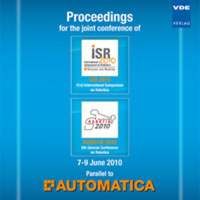Automatic Trajectory Generation for Robotic Painting Application
Konferenz: ISR/ROBOTIK 2010 - ISR 2010 (41st International Symposium on Robotics) and ROBOTIK 2010 (6th German Conference on Robotics)
07.06.2010 - 09.06.2010 in Munich, Germany
Tagungsband: ISR/ROBOTIK 2010
Seiten: 6Sprache: EnglischTyp: PDF
Persönliche VDE-Mitglieder erhalten auf diesen Artikel 10% Rabatt
Autoren:
Li, Xiongzi; Chen, Heping; Fuhlbrigge, Thomas A. (ABB / USCRC, Windsor, CT, USA)
Landsnes, Øyvind A.; Rege, Mary-Ann (ABB / NOATM, Bryne, Norway)
Sudarshan (ABB / INCRC, Bangalore, India)
Inhalt:
Spray Painting is an important application in industrial robotics. Today’s programming for spray gun’s trajectory is mainly done by manually teaching and touching-up. In order to minimize the cycle time and paint waste, it is critical to automate and optimize the trajectory generation. The paper presents the project that ABB has recently accomplished to achieve the goal of automatic path generation. The tasks in the project are: 1. Given the CAD model of the part to be painted, typically a car body, separate the surface into several panels. 2. Generate trajectory on each panel. CAD model processing includes the following steps: mesh CAD model, separate the part by data structure and natural gaps in CAD data, filter smaller parts, partition parts using clipping planes or by user defined poly-line curves, group small parts into panels. CAD model could have several layers, could have many details that are not important for painting - such as door knob, lights, gas tank cover, license plate, etc. these all need to be considered in the CAD model process. One of the critical techniques to handle the CAD model is to calculate the minimum volume bounding box of the part to be painted. Steps in trajectory generation are: select a panel, define the parameters, generate path. There may be holes in the surface which need to be considered. The parameters include: path direction, starting corner, path offset, path pitch size, acceleration distance, deceleration distance, trigger on distance, trigger off distance, etc. Regular style and special painting style (Stay-On) are handled in the project. The project will handle the CAD model and generate the trajectory in ABB’s offline programming and simulation software RobotStudio. Easy-to-use aspect for user interaction is also addressed in this project. Some of the screens are captured and showed below.


